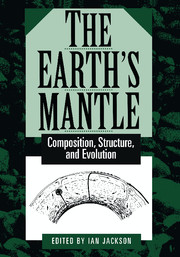Book contents
- Frontmatter
- Contents
- Chapter Outlines
- Contributors
- Dedication
- Preface
- I Accretion and Differentiation of the Earth
- 1 Composition of the Silicate Earth: Implications for Accretion and Core Formation
- 2 Early Differentiation of the Earth: An Isotopic Perspective
- 3 Primordial Solar Noble-Gas Component in the Earth: Consequences for the Origin and Evolution of the Earth and Its Atmosphere
- II Dynamics and Evolution of the Earth's Mantle
- III Structure and Mechanical Behaviour of the Modern Mantle
- Index
2 - Early Differentiation of the Earth: An Isotopic Perspective
Published online by Cambridge University Press: 23 November 2009
- Frontmatter
- Contents
- Chapter Outlines
- Contributors
- Dedication
- Preface
- I Accretion and Differentiation of the Earth
- 1 Composition of the Silicate Earth: Implications for Accretion and Core Formation
- 2 Early Differentiation of the Earth: An Isotopic Perspective
- 3 Primordial Solar Noble-Gas Component in the Earth: Consequences for the Origin and Evolution of the Earth and Its Atmosphere
- II Dynamics and Evolution of the Earth's Mantle
- III Structure and Mechanical Behaviour of the Modern Mantle
- Index
Summary
Introduction
During the past 4.5 billion years the Earth has undergone a complex process of differentiation that has resulted in the formation of a metallic core, a magnesium-rich silicate mantle, and a siliceous continental crust. One of the major challenges for the Earth sciences is not only to document the present-day chemical and physical states of these distinctive regions, but also to unravel the complex series of events associated with their origin and long-term evolution. Isotope geochemistry can provide important constraints on many of these events, as the formation and subsequent differentiation of the Earth were accompanied by chemical fractionation of the parent–daughter elements that comprise many of the naturally occurring radioactive-decay systems. The isotopic compositions of these daughter elements will therefore yield constraints on the timing and magnitude of fractionation events and thus provide insights into the processes responsible for the differentiation of the Earth. In the first part of this chapter we shall show how isotopic systematics, particularly the isotopic compositions of Pb and Sr preserved in ancient terrestrial samples, can be used to constrain the timescales for the Earth's accretion and the formation of its core. The second part of this chapter discusses the constraints on the formation and evolution of the continental crust and upper mantle that are provided by the Sm-Nd isotopic systematics of early Archaean rocks.
Probably the most fundamental question associated with the formation of the Earth is its age.
- Type
- Chapter
- Information
- The Earth's MantleComposition, Structure, and Evolution, pp. 127 - 158Publisher: Cambridge University PressPrint publication year: 1998



